8 Benefits of Meditation for Chronic Pain: Embark on a transformative journey towards managing chronic pain through the power of mindfulness and meditation.
As we delve deeper into the physiological and psychological benefits, explore how meditation can improve quality of life and provide mindfulness techniques for effective pain management.
Introduction to Meditation for Chronic Pain
Chronic pain is defined as persistent pain that lasts for weeks, months, or even years, significantly impacting an individual’s quality of life, daily activities, and mental well-being. It can be caused by various conditions such as arthritis, fibromyalgia, or nerve damage, leading to physical discomfort and emotional distress.Meditation is a practice that involves focusing the mind and achieving a state of deep relaxation.
It has been used for centuries to promote mental clarity, emotional stability, and overall well-being. When it comes to managing chronic pain, meditation can help individuals cope with the physical sensations and emotional challenges associated with their condition.Research studies have shown that meditation can be an effective complementary therapy for chronic pain management. A study published in JAMA Internal Medicine found that mindfulness meditation significantly reduced pain intensity and improved physical function in individuals with chronic lower back pain.
Another study in the Journal of Pain Research indicated that meditation could enhance pain tolerance and reduce pain-related anxiety in patients with chronic pain conditions.
Benefits of Meditation for Chronic Pain
- Mindfulness meditation can help individuals develop a greater awareness of their pain sensations without judgment, leading to reduced pain perception and improved pain coping mechanisms.
- Deep breathing techniques practiced during meditation can promote relaxation and reduce muscle tension, alleviating physical discomfort associated with chronic pain.
- Regular meditation practice can enhance emotional well-being by reducing stress, anxiety, and depression, which are often co-occurring conditions with chronic pain.
- Meditation can improve sleep quality, which is crucial for individuals with chronic pain as proper rest can help manage pain levels and promote healing.
- By increasing mental focus and concentration, meditation can shift the attention away from pain signals, allowing individuals to engage in daily activities more effectively.
- Practicing meditation regularly can lead to neuroplastic changes in the brain, potentially reducing the perception of pain over time.
- Guided imagery meditation techniques can help individuals create positive mental images to counteract negative pain experiences and promote a sense of well-being.
- Group meditation sessions or online communities can provide social support and a sense of belonging for individuals living with chronic pain, reducing feelings of isolation and enhancing overall quality of life.
Physiological Benefits of Meditation: 8 Benefits Of Meditation For Chronic Pain
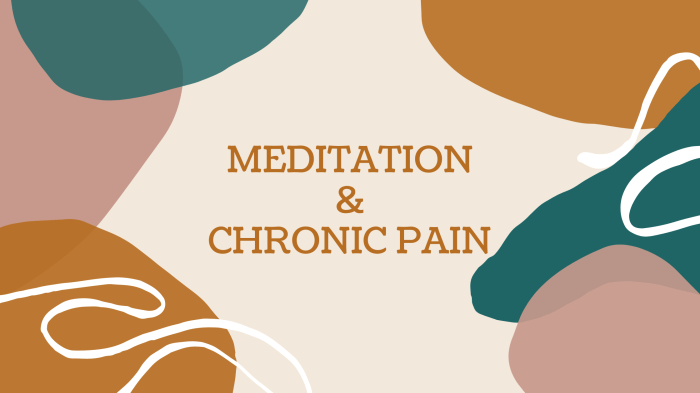
Meditation has been shown to have several physiological benefits for individuals suffering from chronic pain. These benefits include changes in the brain’s perception of pain, reduction in inflammation in the body, and modulation of stress hormones related to chronic pain.
Impact on Brain’s Perception of Pain, 8 Benefits of Meditation for Chronic Pain
Meditation can alter the way the brain processes and perceives pain signals. By practicing mindfulness and focusing on the present moment, individuals can experience a reduction in the intensity of pain they feel. This is attributed to the changes in brain activity that occur during meditation, leading to a decreased sensitivity to pain stimuli.
Reduction in Inflammation
Chronic pain is often associated with inflammation in the body. Meditation has been found to lower levels of inflammatory markers, such as C-reactive protein, in individuals with chronic pain conditions. By reducing inflammation, meditation can help alleviate pain and improve overall well-being.
Modulation of Stress Hormones
Stress plays a significant role in exacerbating chronic pain conditions. Meditation has been shown to regulate stress hormones, such as cortisol, which are linked to the body’s response to pain. By reducing stress levels through meditation, individuals can experience a decrease in the intensity of pain and better management of chronic pain symptoms.
Psychological Benefits of Meditation
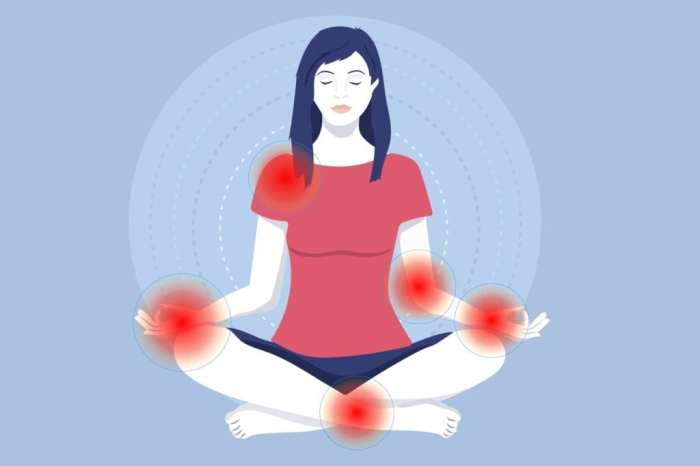
Meditation is not only beneficial for the body but also for the mind. Let’s explore how meditation can improve mood, reduce symptoms of anxiety and depression, and help individuals cope with chronic pain.
Improved Mood and Reduced Anxiety
- Meditation helps individuals focus on the present moment, reducing worry and rumination that can contribute to anxiety.
- By calming the mind and promoting relaxation, meditation can help alleviate symptoms of anxiety and promote a sense of well-being.
- Studies have shown that regular meditation practice can lead to significant reductions in anxiety levels and improvements in overall mood.
Alleviation of Depression Symptoms
- Mindfulness meditation has been found to be effective in reducing symptoms of depression by promoting self-awareness and emotional regulation.
- Through meditation, individuals can develop a greater sense of control over their thoughts and emotions, leading to a decrease in depressive symptoms.
- Research has indicated that meditation can increase levels of neurotransmitters like serotonin, which are associated with mood regulation and happiness.
Connection between Mindfulness and Coping with Chronic Pain
- Practicing mindfulness through meditation can help individuals with chronic pain develop coping mechanisms to deal with their condition.
- By focusing on the present moment and accepting their pain without judgment, individuals can reduce the emotional impact of chronic pain.
- Studies have shown that mindfulness-based interventions, including meditation, can lead to improvements in pain acceptance and reduced pain-related distress.
Improved Quality of Life
Meditation can significantly improve the quality of life for individuals suffering from chronic pain by addressing various aspects of their well-being.
Enhanced Sleep Quality
Meditation has been shown to have a positive impact on sleep quality in individuals with chronic pain. By promoting relaxation and reducing stress levels, meditation can help individuals fall asleep faster, stay asleep longer, and achieve a more restful night’s sleep. This improved sleep quality can lead to better overall physical and mental health.
Increased Mobility and Functionality
Regular meditation practice can also contribute to increased mobility and functionality in individuals with chronic pain. By reducing muscle tension and promoting relaxation, meditation can help alleviate stiffness and improve flexibility. This can ultimately lead to better mobility, allowing individuals to engage in daily activities with greater ease and comfort.
Sense of Empowerment and Control
Meditation can foster a sense of empowerment and control over one’s pain. By teaching individuals to observe their thoughts and emotions without judgment, meditation can help them develop a greater sense of self-awareness and emotional regulation. This increased awareness can lead to a shift in perspective, enabling individuals to manage their pain more effectively and feel more in control of their overall well-being.
Mindfulness Techniques for Pain Management
Mindfulness techniques are powerful tools for managing chronic pain. Consistency in practicing these techniques is key to experiencing long-term relief. By shifting focus away from pain sensations, individuals can improve their quality of life and overall well-being.
Examples of Mindfulness Exercises
- Body Scan: This involves focusing on each part of the body, starting from the toes and moving up to the head, paying attention to any sensations without judgment.
- Deep Breathing: Taking slow, deep breaths while focusing on the sensation of the breath entering and leaving the body can help calm the mind and reduce pain perception.
- Mindful Walking: Walking slowly and deliberately, paying attention to each step and the sensations in the feet and legs, can help bring awareness to the present moment.
Importance of Consistency
Consistency in practicing mindfulness exercises is crucial for long-term pain management. By incorporating these techniques into daily routines, individuals can rewire their brains to respond differently to pain signals over time. Regular practice helps strengthen neural pathways associated with relaxation and pain relief.
Shifting Focus Away from Pain Sensations
One of the key benefits of mindfulness techniques is their ability to help individuals shift their focus away from pain sensations. By bringing attention to the present moment without judgment, individuals can create distance between themselves and their pain, reducing the intensity of the experience. This shift in focus can lead to decreased pain perception and increased overall well-being.
Meditation Practices for Different Types of Chronic Pain
Chronic pain can manifest in various forms and affect individuals differently. Therefore, it is crucial to tailor meditation practices to suit the specific type and severity of chronic pain experienced by each individual. By identifying specific meditation techniques that target different types of chronic pain, individuals can better manage their symptoms and improve their overall well-being.
Arthritis Pain
- Focus on gentle movement meditations, such as yoga or Tai Chi, to alleviate joint pain and stiffness.
- Practice body scan meditations to bring awareness to areas of discomfort and promote relaxation in those areas.
- Utilize visualization techniques to imagine joints moving smoothly and without pain.
Migraine Pain
- Engage in deep breathing exercises to promote relaxation and reduce tension that can trigger migraines.
- Try mindfulness meditation to increase awareness of early migraine symptoms and manage pain before it escalates.
- Use guided imagery to envision a peaceful and pain-free state during migraine attacks.
Back Pain
- Practice mindful stretching to improve flexibility and reduce muscle tension in the back.
- Explore loving-kindness meditation to cultivate feelings of compassion towards oneself and alleviate emotional stress that can exacerbate back pain.
- Use progressive muscle relaxation techniques to release tension in the back muscles and promote overall relaxation.
Neuropathic Pain
- Engage in breath-focused meditations to increase oxygen flow to nerves and reduce neuropathic pain sensations.
- Try body scan meditations to bring attention to areas of nerve pain and release tension through mindfulness.
- Utilize mantra meditation to distract from neuropathic pain signals and promote a sense of calm and well-being.
Incorporating Meditation into Pain Management Plans
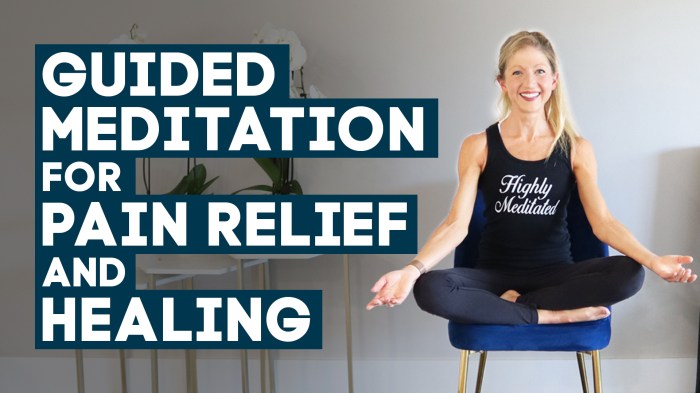
Integrating meditation into pain management plans can offer individuals a holistic approach to dealing with chronic pain. By combining meditation with other therapies, individuals can experience a more comprehensive and effective pain management strategy.
Benefits of Combining Meditation with Other Therapies
- Enhanced pain relief: Meditation can complement traditional pain management techniques such as medication or physical therapy, leading to improved pain relief.
- Reduced stress and anxiety: Combining meditation with therapies focusing on stress reduction can help individuals better cope with the emotional aspects of chronic pain.
- Improved sleep quality: Meditation can promote relaxation and improve sleep patterns, which is crucial for individuals dealing with chronic pain.
Establishing a Meditation Routine for Pain Relief
Resources and tools can assist individuals in incorporating meditation into their pain management plans. By establishing a regular meditation practice, individuals can experience long-term benefits in managing chronic pain.
Potential Challenges and How to Overcome Them
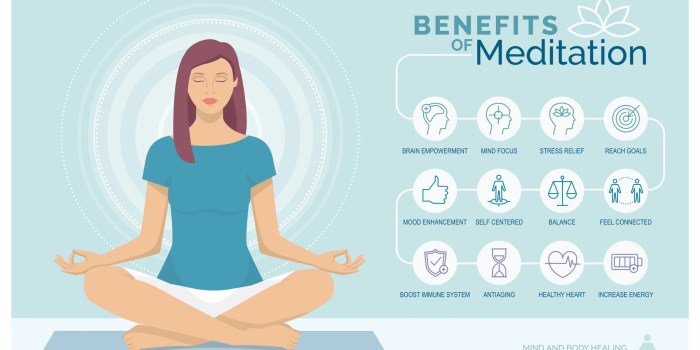
Chronic pain sufferers may encounter various challenges when trying to incorporate meditation into their pain management routine. It is essential to address these obstacles effectively to fully harness the benefits of meditation for chronic pain relief.
Managing Discomfort and Distractions
- Practice gentle movements or stretches before meditation to help alleviate physical discomfort.
- Experiment with different meditation postures or positions to find the most comfortable one for you.
- Use cushions or props to support your body and reduce strain during meditation sessions.
- Acknowledge distractions such as pain or intrusive thoughts without judgment and gently redirect your focus back to the present moment.
Developing Patience and Persistence
- Understand that progress in meditation practice takes time, and results may not be immediate. Be patient with yourself.
- Set realistic expectations and allow yourself to experience the process without putting pressure on achieving specific outcomes.
- Consistency is key – commit to a regular meditation practice even on days when it feels challenging or uncomfortable.
- Seek support from meditation communities, online resources, or healthcare professionals to stay motivated and accountable in your journey.
Epilogue
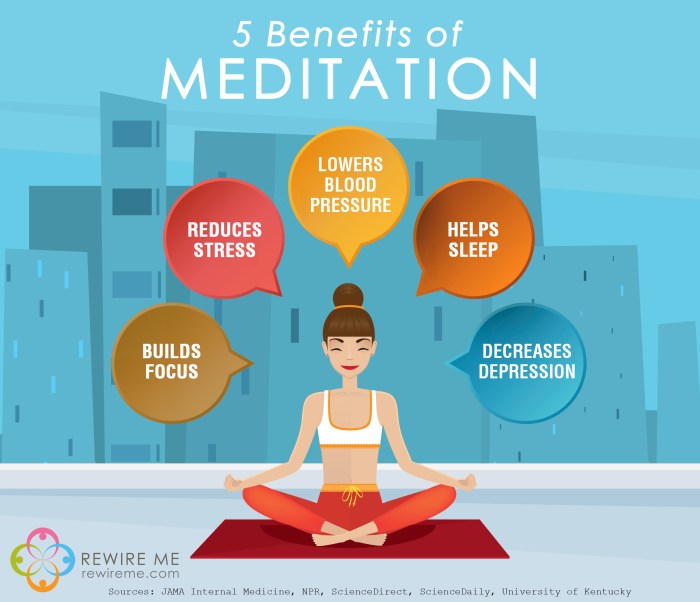
In conclusion, embracing meditation as part of your pain management plan can lead to a significant improvement in your overall wellbeing. By overcoming potential challenges and incorporating meditation into your daily routine, you can experience a profound shift in how you perceive and cope with chronic pain.